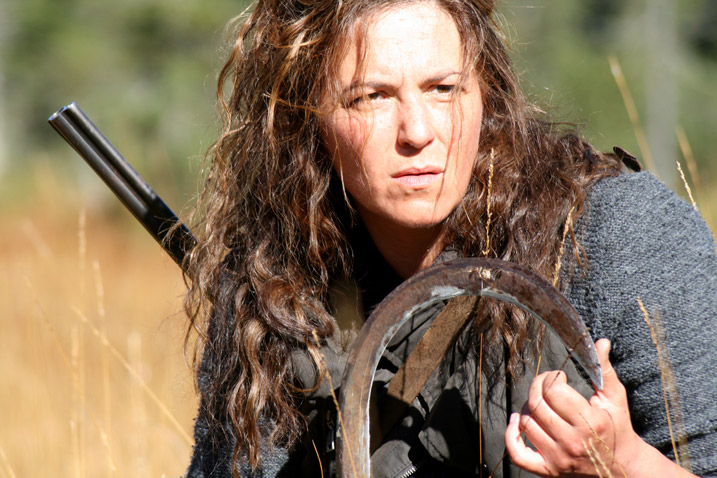 The term “adaptation” seems to escape certain filmmakers,
The term “adaptation” seems to escape certain filmmakers,
flummoxing those who seem absolutely wedded to their material. It squanders a
great deal of potential when stories, themes and characters are followed to the
letter, ignoring that the shift from one medium to another requires a
tremendous transformation of the source material. That seems to be the chief
problem with Julian Pölsler’s “The Wall,” an elegiac new film that can’t seem to get out of its
own way in an attempt to tell its own story, to the point where it feels like
two distinctly different warring sensibilities at play.
Martina Gedeck is a single woman who embarks upon a hunting
lodge with friends, only to be left behind when they head out of town. So
accustomed to city life that she enters this gorgeous mountainside cabin
blaring American pop music, absolutely terrified by, of all things, their
domesticated dog Lynx. She thinks nothing of it when her friends don’t return,
surveying the cabin as if the silence were some sort of creeping monster and
not something to embrace and appreciate. A short walk down the road gives her
the uneasy answer: the cabin has been closed off by an invisible, unmoving wall
that stretches an untold distance, completely restricting her access to the
outside world.

Normally this sort of discovery is followed by a type of
fantasy adventure where a cagey protagonist summons his or her wits to travel
the length of the wall and find an escape. The unnamed protagonist of “The Wall,”
however, assumes this is some sort of karmic retribution and accepts her lot,
opting instead to stay within her means and man the grounds. The physics of the
wall are never explained, nor is the fact that she can plainly see neighbors on
the other side, frozen in time, though it doesn’t keep her from crossing days off
the calendar in an attempt to maintain some sort of order. As the days rush on,
she realizes she would have to head deep into the mountains to find a
hypothetical end of the wall. And that would be exciting and heroic and
everything, but who’s gonna feed this cow?
This setup is inherently cinematic, until the realization
sets in that every single moment of this film is layered with narration. It
wouldn’t take someone with a press kit to notice that these are entire passages
simply cut and pasted from the original novel by Marlen Haushofer. On some occasions, that proves to
be useful, as this unnamed woman doesn’t exactly have anyone to talk to, and
eventually assigns personality traits to her only companions, including Lynx, a
cat named Pearl, and a cow named Bella. But there’s not a lot that can’t be
conveyed by dialogue, or isn’t already established by the visuals. Gedeck’s
secluded spirit has no television or internet, and no phone connecting her to
the outside world, but it’s days before she actually attempts to turn on the
radio, finding only static. This would help us learn that she’s already a
little unplugged by the time she gets to the cabin, but that’s the sort of
thing we could discover through the silent passages of her hiking in the
neighboring areas. More importantly, why is this Austrian woman speaking in
English? For whom is this a commercial consideration?

The images of “The Wall” pack a certain pastoral strength,
reflected on the weathered face of Gedeck’s isolated heroine, who eventually
must hunt and scrounge for food, almost as if she wasn’t frozen in time, but
moving backwards. What thrill would there be had this been an almost entirely
non-verbal film, if it were just about the deterioration of one woman’s spirit
in the face of improbable adversity? It would feel much like observational docs
like “Sweetgrass,” where the camera doesn’t judge as it captures the actions of
workers living off the fat of the land, embracing their surroundings as if it
were destiny. Instead, a journal is used as a framing device, as she catalogs
each day from the other side of the wall, attempting to avoid losing faith.
To feel the need to document such a thing seems like an
active character trait, though the character we see seems more about
self-preservation, and eventually the cruelties of nature, moreso than a sense
of recognition. This need to document would make sense had she attempted to
leave her mark on her surrounding area; perhaps a flag, maybe some sort of
symbol on the side of a rock. Instead, “The Wall” seems to be telling the story
about assimilation, about a woman who accepts her lot and attempts to persevere
through the cruelest of conditions, an unspoken martyr. Perhaps it would carry
much more power had she not been so chatty. [B-]






it must have been a commercial consideration for producers, because I saw it last year at a film festival and the narration was in german (with english subtitles)